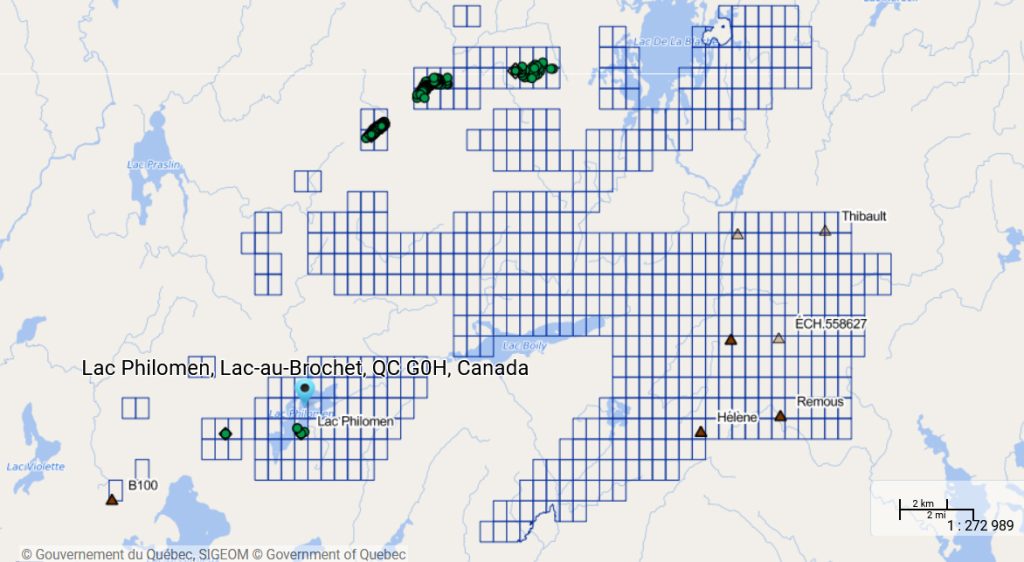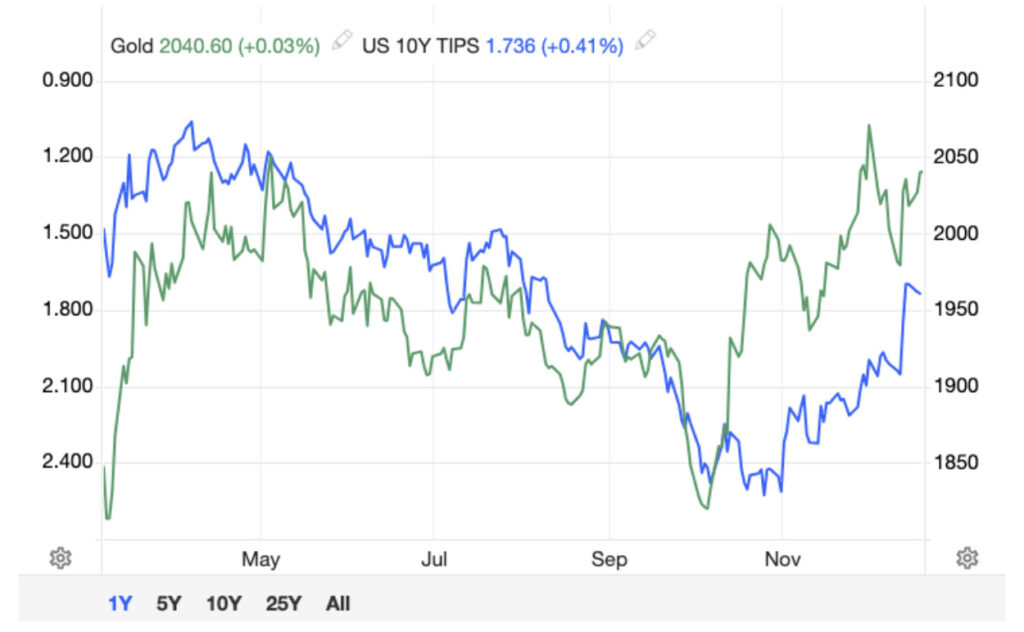Companies
The Julie Nickel-Copper-Cobalt-PGE Project – St-Georges Eco-Mining (CSE: SX – OTC: SXOOF)
Introduction St-Georges Eco-Mining Corp. (CSE: SX) (OTCQB: SXOOF) (FSE: 85G1) is a junior exploration company with a portfolio of Critical and Strategic…

Introduction
St-Georges Eco-Mining Corp. (CSE: SX) (OTCQB: SXOOF) (FSE: 85G1) is a junior exploration company with a portfolio of Critical and Strategic Minerals Projects, including the Manicouagan Project, the Julie Project, and the Notre-Dame Niobium Project, all located in Quebec, Canada. Through its subsidiary, Iceland Resources, the Company owns all the active exploration licenses in the country, including the Thor Gold Project. Using an eco-mining approach, the Company develops metallurgical technologies through its subsidiary, St-Georges Metallurgy, including a new system for processing lithium, which it then applied to battery recycling through its subsidiary, EVSX. The Company expanded into indigo hydrogen with its H2SX subsidiary to support its metallurgical process that allows battery recycling and lithium hydroxide production. Together, the synergies between St-Georges and its subsidiaries create a circular green economy focusing on the critical and strategic minerals supply chain.

Summary
- Project Overview – A brief description of the Julie Critical and Strategic Minerals Project
- Project History – A detailed account of all historical work done on the property going back to the first discoveries on the property
- St-Georges Eco-Mining Exploration History – A detailed account of the Company’s exploration efforts and results since acquiring the project.
- More Current Exploration
- 2021 Exploration Summary of The Julie Project
- Current Activities – Discussing the current status of the project.
Project Overview
The Julie Critical and Strategic Minerals Project is about 150km northwest of Baie-Comeau and along the north shore of the mining-friendly province of Québec, Canada, and covers approximately 3,047 hectares. The Project is ideally situated in close proximity to the deep-seaport town of Baie-Comeau. The Project is easily accessible via gravel and logging roads. The Project is explored for nickel, copper, cobalt, and platinum group elements. It will be focused on in parallel to establishing the Company’s Nickel Center of Excellence in Baie-Comeau.
Figure 1: Claim Boundaries (Not all claims in this image belong to St-Georges, see figure 5)
Project History
Disclaimer: Historical information is provided solely for the reader’s convenience and has been sourced from publicly available sources. St-Georges Eco-Mining Corp is not responsible for the content’s accuracy, currency, or reliability, nor does the Company offer any guarantees in this regard.
- Between 1968 and 1970, a mapping program at a 1:250,000 scale occurred. Around the same time, the Geological Survey of Canada produced the first airborne magnetic maps of the Lac Mapret and Lac Matamec region, which encompasses the Julie Property.
- In 1976, SOQUEM carried out an exploration campaign covering an area of 34,700 km2. The campaign included Lake Sediment geochemistry, airborne radiometrics, and geological surveying. Pieces of the report were published through the MRNFQ between 1984 and 1987.
- In 1998, the initial discovery of nickel and copper at Julie was made by Otokumpu in collaboration with the local prospectors association.
- In 1998, Outokumpu Mines Inc. performed Helicopter Mag and Electromag surveys covering 2,519 line-kilometers, as well as ground geophysical surveys and geological mapping of the Lac Blanche and Julie Properties. As part of this exploration campaign, the company highlighted a dyke or sill that contained up to 1.51% Ni and 0.31% Cu.
- In 2000, the FREM and Bourque Brothers prospected the Lac La Blache Ni-Cu occurrence. They undertook line-cutting (nine lines for 600 meters total length at 100-meter spacing) for Beep-mat prospecting and an electro-magnetic VLF survey. Twenty-one (21) samples were collected in five trenches with a highlight of 1.33 % Ni and 0.28 % Cu over 2 meters.
- In 2000, the Centre associé en transfert de technologie en foresterie du Cégep de Baie-Comeau (“CERFO”) assisted local prospectors (GM59562, GM59574, and GM59575) in the area of Lac La Blache for Beep-mat prospecting. They discovered the Hélène occurrence, a small massive sulphide composed of 95 % pyrrhotite, 5 % chalcopyrite, up to 0.71% Cu, and 0.25 % Ni located more than 4 km southwest of the Julie occurrence.
- In 2001, the Couturier family undertook prospecting in order to find an extension of the Hélène occurrence, which consisted of soil sampling and a VLF geophysical survey.
- Between 2002 and 2004, Gemme Manicouagan Inc. completed geological mapping and outcrop stripping.
- The Julie Nickel Project was acquired privately by St-Georges Minerals in 2007.
St-Georges Eco-Mining Exploration History
- During February and March of 2011, Geophysics GPR International Inc. flew a high-sensitivity airborne magnetic geophysical survey commissioned by NORAM Engineering and Mining Corp. on behalf of the Company. The survey was composed of one block for a minimum of 3735 line-km coverage. (See Figure 2)
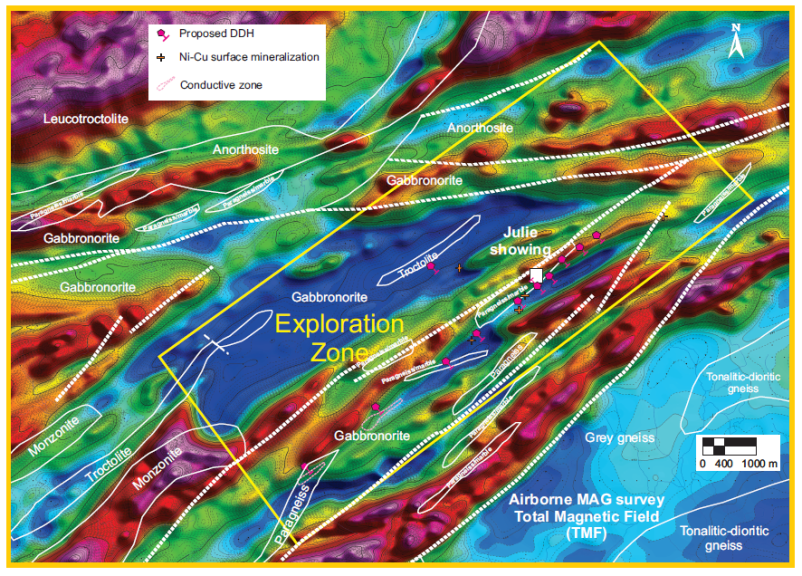
- In 2014, the Company announced that they identified a 1.5 km corridor of sulphide-impregnated rock that was mapped at surface. Mineralization occurs intermittently over a 1.5 km strike length by 200 meters wide, and several large sulphide-rich outcrops were identified. One channel sample returned grades of 11.64 meters, grading 1.82% nickel, 0.29% copper, and 0.04% cobalt.
- In November 2018, the Company undertook a percussive hammer drilling campaign on the Julie Nickel Showing and along the northeast extensions. Six vertical drill holes, 10 to 15 meters long by 10 cm hole diameter, were drilled directly on the outcropping with nickel-copper mineralization. Each sample taken consisted of a 1.5m length weighing approximately 25 kg each. These samples were bagged, identified, sealed, and processed at the laboratory of the Magnor Exploration Inc. geoscience contractor of the Company. The samples were unpacked and processed by a certified geochemist. The geochemist proceeded to homogenize and separate into several equal samples using a riffle splitter and verify the homogeneity of all samples by multiple measurements of nickel with a handheld XRF Vanta analyzer. Only two samples from Hole JU-18-01 (from 0.0 to 1.5m, 0.75kg weight) and from Hole JU-18-03 (from 0.0 to 1.5m, 0.87kg weight) with significant nickel content identified by XRF instrument were selected for assay at a certified laboratory. The two composite samples, weighing less than 1 kg, were bagged, sealed, identified, and shipped to the certified ALS laboratory in Val d’Or, Québec. ALS lab treated the samples by fine crushing, splitting, and pulverizing. Finally, the samples were analyzed for precious and base metals by ICP-MS and ICP-AES for high-graded nickel samples.

Significant nickel assay results of 1.56% nickel over 1.5 meters and 0.47% nickel over 1.5 meters were obtained from assayed cutting samples from Julie Ni-Cu Showing. The nature of the rocks sampled consists of pyrrhotite-pentlandite-bearing (iron and nickel sulfides) stringers and clusters (5-15% volume rock) hosted in strongly foliated leuco-gabbronorite.
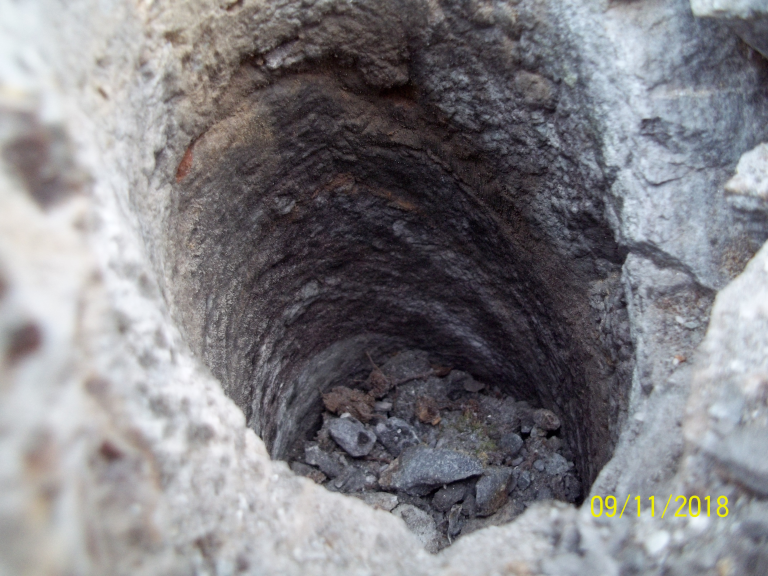
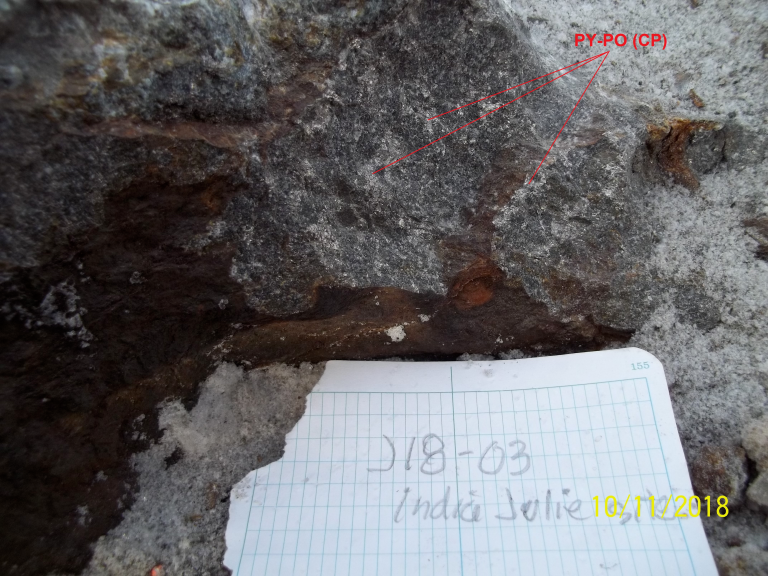
* The balance of the material not sent to the independent laboratory for assays was delivered to the St-Georges Metallurgy team for bulk processing in support of research and development initiatives.
- In 2019-20, the Company’s geological team collected over 100 kg of material from Julie’s trench #1 location to conduct a small bulk processing program. Characterization and metallurgical testing were conducted, as well as tests with the Company’s green nickel processing technology in development. Initial metallurgy for the material encountered had a primary focus on nickel and copper, but with additional optimization of the recovery process of the by-products identified, such as sulfur, the Company could potentially provide sulfuric acid to third-party industrial projects being developed on the Québec North Shore.
The metallurgical work was conducted with Coalia at their installations under the supervision of Enrico Di Cesare, St-Georges’ Vice-President of Research and Development. Shareholders are cautioned that the data obtained comes from the bulk samples, which were chosen for their known content in nickel and copper within Trench 1. It is too early in the Project’s exploration and development to know if these results could be considered representative of the Project’s general metallurgy.
The nickel found in the historical and recent assays seems to be located almost exclusively in the pentlandite found in the system. The recrystallized nature of the pentlandite on Julie seems to indicate an easy crystal to recover with flotation, and the early microscopic evaluation indicates it should not be difficult to process and recover the nickel. This crystal chemistry is (NiFe)9S8. This type of nickel has the ideal ratio of 1 to 1 for nickel to iron, which helps reduce chemical costs lost to the iron. This type of nickel can also complement ferro-nickel projects.
The following tables (Tables 1 and 2) represent the mineral composition of the sample delivered to Coalia Labs.
Table 1: Mineral composition of the sample delivered to Coalia Labs

Table 2: Mineral composition of the sample delivered to Coalia Labs
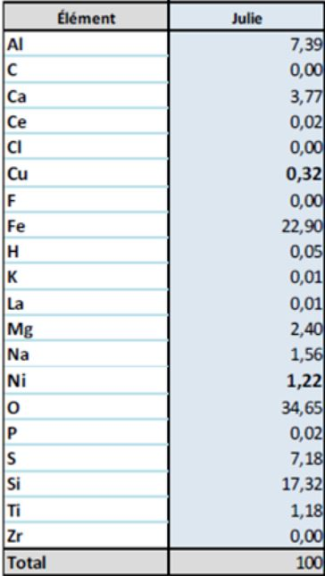
The recrystallized copper-bearing chalcopyrite (CuFeS2) is expected to be a candidate for recovery by flotation, making it a potentially important credit to any proposed industrial processing operation. The Company intends to evaluate different options to optimize the value of the by-products, including cobalt, which will be focused on in later stages as cobalt is commonly used in lithium-ion batteries and could be a potential stock feed blend for the battery recycling plant and Nickel Center of Excellence in Baie-Comeau, Québec currently being established by EVSX, a subsidiary of St-Georges Eco-Mining.
More Current Exploration
The initial interpretation of the results, coupled with the results from bulk sampling from a percussive drilling campaign alongside the reinterpretation of historical work program results, led the Company to almost double the land size of the Project.
- In February 2021, the Company completed a surface geophysics campaign and contracted an independent third party to provide a preliminary geophysical report.
- In February 2021, the Company added 65 new mining claims through electronic map staking to the existing claims.
- In May 2021, the Company announced the launch of a planned 11,600-meter drill program to be executed in two phases.
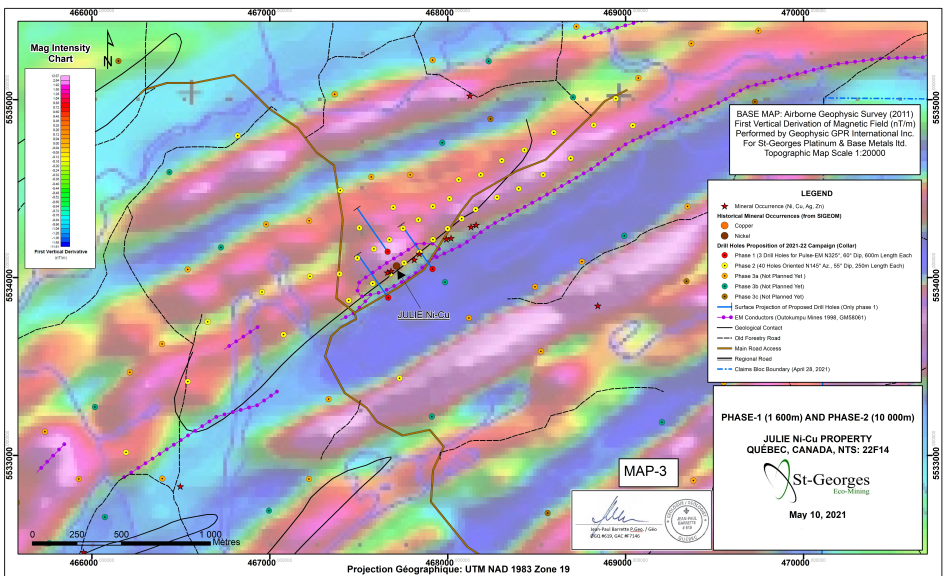
- In June 2021, the Company acquired 147 new claims through electronic map staking.
- In July 2021, the Company reconditioned and repaired approximately 30 km of logging roads on the Julie Project.
- In August 2021, the Company launched its drill campaign and agreed to acquire an additional 28 mineral claims from an arms-length vendor. Some of these claims were land-locked within the other exploration licenses held by the Company, while the bulk were located to the south and southwest boundaries of the Project.
The terms of the acquisition were; the issuance of 100,000 common shares of St-Georges within 30 days of the approval of the transaction and the payment of CA$50,000 under the same terms. The agreement also called for the signing of an NSR agreement within 60 days following the acquisition. The NSR covering these claims was set at 1%, of which 0.5% can be bought back for CA$1,000,000 at any time at the Company’s discretion. The agreement also established a 10 km zone of influence in favor of the Company.
These new mineral claims represent an increase of approximately 1,512 hectares of the Project’s footprint.

- In November 2021, the Company announced that a total of 4,198 meters over 11 holes were drilled on Julie, the bulk of which consisted of holes positioned to conduct borehole geophysical testing to help identify targets for the second phase of exploration drilling and understand the structure and stratigraphy of Julie. Additional material was collected in the initial surface exploration phase by a surface sampling and channel-cutting crew.
- On December 29, the Company released the full results of its exploration efforts.
2021 Exploration Summary of The Julie Project
From May to July 2021, field prospecting work (Phase 1 of the fieldwork program) with a Beep-mat instrument was utilized on several parts of the claims comprising the Julie Project (approximately 2,495 hectares or 25 square kilometers) (Figures 6 to 8, Table 3 below). Several historical nickel and copper mineralized showings, as well as zinc and silver mineral occurrences, were summarily investigated to confirm their location and level of access. The geological team also identified extensions to known mineralization. A total of 140 grab, chip, and/or channel line samples were collected for further evaluation. This included 29 meters of channel cuts. This prospecting work covered the trench known as Julie Ni-Cu2, Trench Number 9, a Zn-Ag-Cu showing, and the Remous Ni-Cu Showing. Work was also expanded to a new block of claims west and north and contiguous with the main Julie claim position (historically held by St-Georges). This new area is identified as the Lac Boily area.
Only small sections of the Julie Project have been prospected to date. In many cases, areas with dated historical information were difficult to access with heavy equipment or, in some cases, even by foot because of the mature vegetation which had regrown on old forest roads.
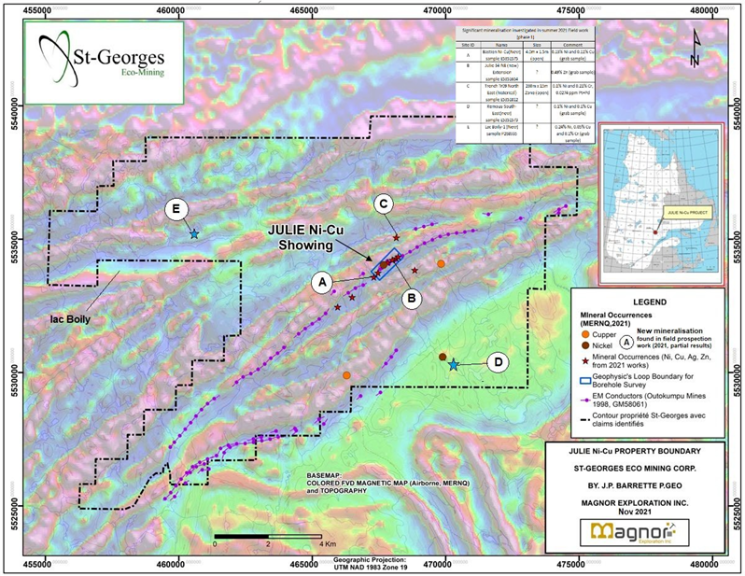
1. Magnetic susceptibility and relative EM conductivity detector From GDD geophysics instruments
2. The Julie Ni-Cu Historical Showing was investigated in late summer 2021 (July to Sept, Phase 2 of the field exploration program)

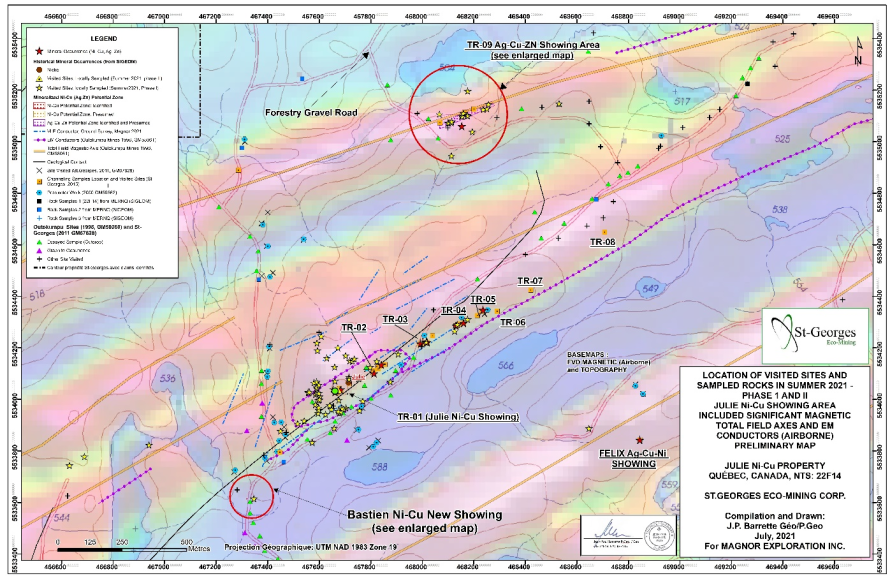
Notable results from the surface work campaign are shown in Table 3, and readers will find detailed descriptions hereinafter.
Site (A): The new Bastien Ni-Cu Mineralized Showing is located 575m southwest of the Julie Ni-Cu Showing. This area could constitute a possible southwest extension of the Julie (T1) Historical Showing. The Showing was discovered immediately adjacent to the cleared access road. After manual stripping, a semi-massive to massive sulfides lens of pyrrhotite, pyrite, and chalcopyrite was exposed. The mineralization is narrow, deformed, and discontinuous. The mineralization appears to be strongly fractured within brecciated gabbronorite and pyroxenite. It was observed over approximately 4 square meters. A grab sample returned 0.13% nickel and 0.11% Cu.
Site (B): About 300 meters northeast of the Julie (T1) Showing, a grab sample was taken outside the historical trench within what appears to be graphitic and sulfide-rich metasediments which carry 5 to 10% sulfides, mainly pyrite. The sample grade was 0.50% zinc. No further work has been done on this target.
Site (C): Close to the historical Trench #9, a Zn-Ag-Cu mineral occurrence was located about 1,275 meters from Julie (T1) Showing. A grab sample from the northeast extension of the historical trench returned grades of 0.1% nickel and 0.21% chromium. The mineralization appears to be hosted in biotite-garnet-magnetite bearing paragneiss.
Site (D): Located approximately 600 meters southeast of the historical Remous Showing. A grab sample from the anorthosite with 1 to 3% sulfides at surface returned grades of 0.1% nickel and 0.1% copper.
Site (E): Several channel cuts and rock samples have been collected in the northwest section of the newly acquired claims north of the Lac Boily area. Historically, this section of claims has been underexplored by the Company, and the area was not renewed for many years until recently. A team of geologists from the Company scouted the area. The sector contains a rusty stained zone covering approximately 8 km x 3 km (A. Berclaz 2021). The zone consists of extensive rusty patched feldspar-quartz porphyritic felsic intrusion, possibly associated with leuco to melanocratic gabbro (possibly gabbronorite) intruding pillowed metabasaltic host rock formation. The dike or stock identified is strongly cataclastic and brecciated with numerous small to large polylithic enclaves composed of fine to coarse-grained felsic rock with inclusions of rusty stained mafic and ultramafic rocks.
A sample taken in siliceous hornblende-biotite bearing metabasalt containing 1-2% sulfides in relative contact with the felsic dike returned grades of 0.23% nickel, 0.1% chromium, and 0.05% copper.
Table 3: Significant results from summer 2021 fieldwork (Phase 1)

Phase 2: 2021 fieldwork program (July-Oct 2021)
Phase 2 of the field program was mainly conducted in the vicinity of the historical trench of Julie Ni-Cu Showing (T1) and along the observed northeast extension. This mineralized zone extends for at least 1,200 meters and is up to several meters in width. Several old trenches (Trench T2 to Trench T8) were observed in the NE extension zone. Trenches T1, T2, and T3 were the only ones targeted in this effort with partial to extensive analysis, mapping, and surface sampling. The samples consisted of grab samples, channel cuts, bulk sampling, and portable drill core sampling. (See Table 4, Figures 9 and 10).
A bulk sampling of 170kg of mineralization hosted in trench T-1 (same as Figure 10) was collected. This bulk sample will be used to conduct further metallurgical tests by the Company’s personnel. Elsewhere on the project, historical showings were revisited, as well as new targets. Geological mapping and sampling were completed on these areas. Overall, a total of 107 grab samples, 84 meters of channel cut samples, and some portable drill core samples were taken during Phase 2 of the fieldwork effort. The significant results of Phase 2 that were received at the time of this press release are shown in Table 4.
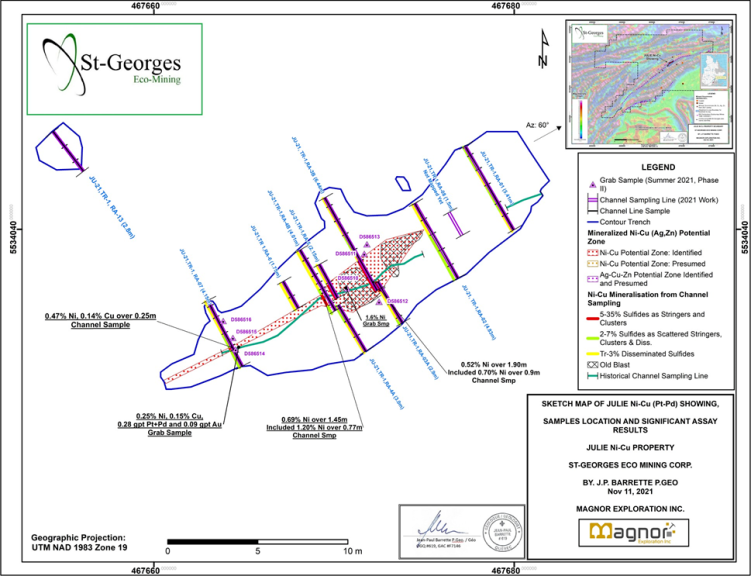
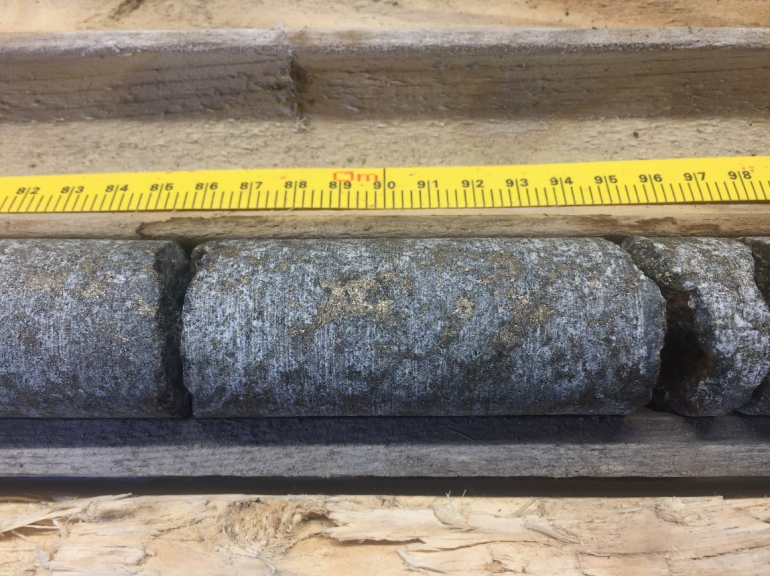
Table 4. Significant mineralization results from Phase 2 of 2021 field exploration (Below)

Borehole geophysics target generation on the Julie Project
A TDEM (Time Domain Pulse EM) geophysics survey was undertaken in October 2021 on three drill holes, JU21-01 (40-490m along hole), JU21-03 (40-490m), and JU21-04 (40-520m) by TMC Geophysics. They used a Crone Pulse EM system. The TDEM readings were completed with a CDR-4 receiver operated in cable synchronization mode. The transmitter Tx loop dimension is 450m x 1100m, inside which the three drill holes occur. The best-defined anomalies were identified and then modeled using the Maxwell software package, for which results are provided in the form of thin plates. Six (6) TDEM conductors were identified, characterized by well-defined early to mid-time channel off-hole response (Figures 11 and 12). Only one conductor (BHEM- JU213-C) of the six TDEM conductors was tested by drilling. Hole JU21-10 alongside this[PP1] conductor and intersected weakly mineralized rock at the approximate depths suggested. The other conductors will be tested in the next phase.
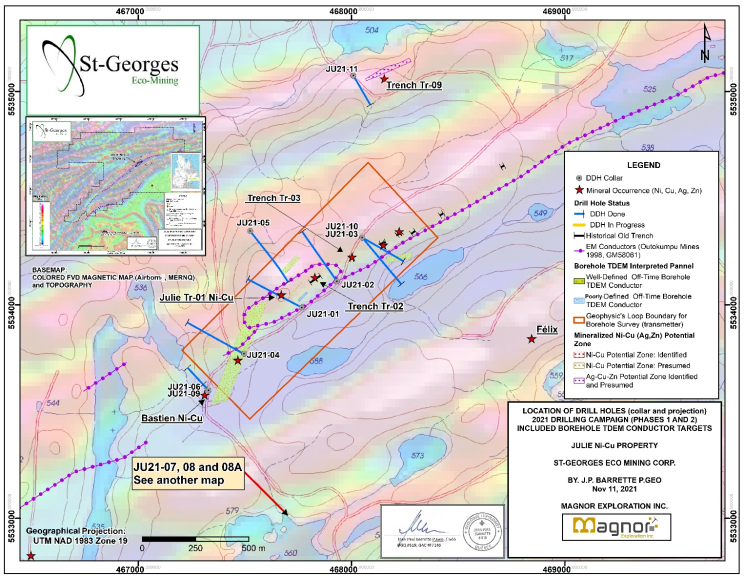

2021 Drill Campaign
Eleven (11) drill holes were completed totaling 4,198 meters of NQ-size core. The drilling tested areas of Julie Ni-Cu mineralization area, Trench T9, Bastien, and Remous Showings (See Table 5 and Figures 11 and 13).
Phase 1 of the drilling campaign (5 Drill Holes JU21-01 to 05 totalized 2,256 m) was primarily designed to identify stratigraphy and to test for geophysical signatures below surface mineralization. The drill holes are concordant and discordant to the stratigraphy. The drilling campaign was also planned to test for the presence of discordant Ni-Cu mineralization, such as feeder pipes or dikes of Ni-Cu-PGE mineralization underlying the Julie Ni-Cu (Zn, Ag) mineralized zone, including Julie T11. The Julie Zone has been defined by Historical Trenches T1 to T5 oriented N60°E (Figure 13). This zone (1200m x 0.5-3.0m) is located on the margin of a high magnetic anomaly oriented N60°. It is coincident with a regional EM anomaly. Only Drill Holes JU21-01, 03, and 04 were used for the borehole survey.
Phase 2 (six holes totaling 1,642m) was undertaken to test for continuity at depth and along strike of Ni-Cu and Zn-Ag mineralization at the Bastien, Remous, and T9 Showings. Only Hole JU21-10 targeted one of the high-priority TDEM conductors, JU213-1C. The other downhole TDEM anomalies will be tested in further drilling campaigns.
Table 5: List of drill holes (NQ) from the 2021 drilling (Phases 1 and 2), Julie Project (updated Dec 2021)
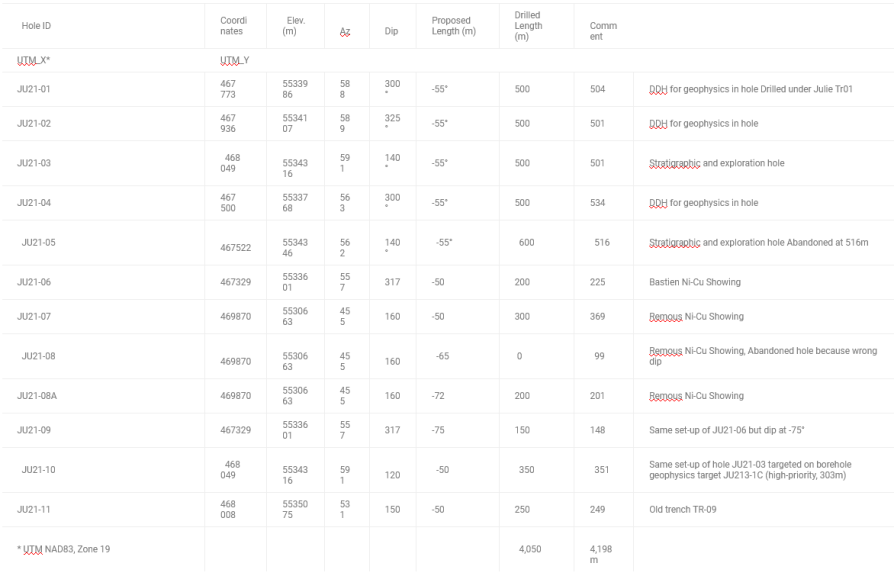

Current Activity
During the 2023 field season, wildfires throughout Québec have hindered the Company’s ability to access the property and complete any field work. Plans to renew fieldwork will be heavily influenced by restrictions imposed by the government during this field season.
Upon the release of new information, this article will be updated.
Disclosure
At the time of creation, St-Georges Eco-Mining is a client of Insidexploration Analytics Inc.
Disclaimer
Project Reports are under the Issuers editorial control and published on Insidexploration. Information contained in Project Reports may change over time and may differ from other sources. For more information, please reference www.stgeorgescoming.ca for Corporate, Technical Information and Project Specifications for the latest public disclosures.
Further;
The information herein is meant for informational and entertainment purposes only and does not constitute a recommendation to buy or sell securities. While every effort is taken to ensure the accuracy of everything contained on this website, no warranty of same is expressed or implied. While we endeavour to keep the information up to date and correct, we make no representations or warranties of any kind, express or implied, about the completeness, accuracy, reliability, suitability or availability with respect to the website or the information, products, services, or related graphics contained on the website for any purpose. While every caution has been taken to provide readers with most accurate information, we recommend that you consult a registered investment professional in your jurisdiction before undertaking any investment in any asset whatsoever.
All Issuer content within this space is considered authored by the Company as an extension of its digital presence. All copyrights are retained by each respective creator(s).
_____________________________________________________________________________________
Information within this document was sourced from:
- https://www.stgeorgesecomining.com
- www.mrnfp.gouv.qc.ca/mines/index.jsp
- https://sigeom.mines.gouv.qc.ca/signet/classes/I1108_afchCarteIntr
- https://backend.otcmarkets.com/otcapi/company/research/66939/content
- https://www.thenewswire.com/
- www.soquem.com
- https://www.sedar.com
cse
otc
otcqb
lithium
cobalt
nickel
copper
zinc
iron
niobium
cse-sx
st-georges-eco-mining-corp
st-georges eco-mining corp

Dolly Varden consolidates Big Bulk copper-gold porphyry by acquiring southern-portion claims – Richard Mills
2023.12.22
Dolly Varden Silver’s (TSXV:DV, OTCQX:DOLLF) stock price shot up 16 cents for a gain of 20% Thursday, after announcing a consolidation of…
GoldTalks: Going big on ASX-listed gold stocks
Aussie investors are spoiled for choice when it comes to listed goldies, says Kyle Rodda. Here are 3 blue chips … Read More
The post GoldTalks: Going…
Gold Digger: ‘Assured growth’ – central bank buying spree set to drive gold higher in 2024
Central banks will drive the price of gold higher in 2024, believe various analysts Spot gold prices seem stable to … Read More
The post Gold Digger:…
